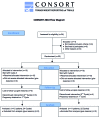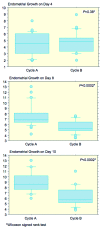Tadalafil for Endometrial Growth in Clomiphene Citrate stimulated cycles in an IUI programma: A pilot study
- PMID: 27729968
- PMCID: PMC5058412
Tadalafil for Endometrial Growth in Clomiphene Citrate stimulated cycles in an IUI programma: A pilot study
Abstract
Aim of the study: The objective of this study was to assess the impact of tadalafil on endometrial growth, the uterine artery pulsatility index (PI) and the uterine artery resistance index (RI) in patients under clomiphene ovarian stimulation for intrauterine insemination (IUI).
Methods: This randomized crossover study included 30 patients with a normal endometrium over 53 cycles, and 46 of those cycles in 23 patients were included in the analysis. In group A the patients were under 100 mg clomiphene daily for five days (2-6) and 5 mg tadalafil daily for 7 days (4-10). For Group B (control) the patients only received clomiphene. Measurements of the endometrium, PI, RI and estradiol determinations were taken on cycle days 4, 8 and 10.
Results: We observed a better endometrial growth in Group A compared to Group B: 7.5 ± 2.1 mm vs 5.5 ± 1.2 mm, P < 0.0002 and 8.9 ± 1.8 mm vs 6.3 ± 1.8 mm, P < 0.0002 on days 8 and 10, respectively. Additionally, a progressive decrease in the RI was observed in Group A but not in Group B from day 8 (0.77 ± 0.15 vs 0.85 ± 0.18, P = 0.059) to day 10 (0.74 ± 0.20 vs 0.87 ± 0.14, P < 0.017). However, no differences were observed in PI or serum estradiol between Group A and Group B.
Conclusion: The use of tadalafil improved endometrial growth in patients under clomiphene ovarian stimulation with no significant effect on the uterine artery Pulsatility Index and serum estradiol.
Keywords: Clomiphene citrate; Endometrial growth; Pulsatility Index; Resistance Index; Tadalafil; ovarian stimulation.
Figures
References
-
- Abdalla HI, Brooks AA, Johnson MR, et al. Endometrial thickness: a predictor of implantation in ovum recipients? Hum Reprod. 1994;9:363–365. - PubMed
-
- Fanchin R, Schonauer LM, Righini C, et al. Serum anti-Mullerian hormone is more strongly related to ovarian follicular status than serum inhibin B, estradiol, FSH and LH on day 3. Hum Reprod. 2003;18:323–327. - PubMed
LinkOut - more resources
Full Text Sources
Research Materials
Miscellaneous



